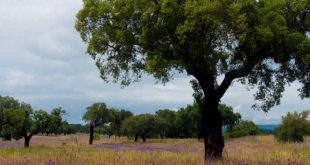Cork Tree — Phellodendron or Cork-tree, is a genus of deciduous trees in the family Rutaceae, native to east and northeast Asia. It has leathery, pinnate leaves and yellow, clumped flowers. The name refers to the thick and corky bark of some (but not all) species in the genus. As an ornamental plant, Phellodendron is a tree for all seasons. …
Read More »Cork Oak Tree Encyclopedia
Kingdom: Plantae Family: Fagaceae Order: Fagales Genus: Quercus Cork Oak Tree — The Cork Oak (Quercus suber) is a medium-sized, evergreen oak tree in the section Quercus sect. Cerris. It is native to southwest Europe and northwest Africa. It grows to up to 20 m, although it is typically more stunted in its native environment. The leaves are 4-7 cm …
Read More »Coriander
Coriander — Coriander, Coriandrum sativum, also commonly called cilantro, is an annual herb in the family Apiaceae. Coriander is native to southwestern Asia and west to north Africa. It is a soft, hairless plant growing to 50 cm [20 in.] tall. The leaves are variable in shape, broadly lobed at the base of the plant, and slender and feathery higher …
Read More »Coneflower
Coneflower — Rudbeckia is one of at least four genera within the flowering plant family Asteraceae whose members are commonly known as coneflowers; the others are Echinacea, Dracopis and Ratibida. They are herbaceous, mostly perennial plants (some annual or biennial) growing to 0.5-3 m tall, with simple or branched stems. The leaves are spirally arranged, entire to deeply lobed, 5-25 …
Read More »Columbine
Columbine — Aquilegia (columbine) is a genus of about 60-70 species of herbaceous perennial plants that are found in meadows, woodlands, and at higher altitudes throughout the Northern Hemisphere. They are known for their distinctive flowers, generally bell-shaped, with each petal modified into an elongated nectar spur. Its fruit takes the form of a follicle. Several species are grown in …
Read More »Collard
Collard — Collards, also called borekale (from the Dutch boerenkool (farmerskale), Brassica oleracea Acephala Group), are various loose-leafed cultivars of the cabbage plant. The plant is grown for its large, dark-colored, edible leaves and as a garden ornamental, mainly in Brazil, Portugal, the Southern United States, many parts of Africa, Montenegro, Spain and in Kashmir as well. They are classified …
Read More »Coconut
Coconut — The Coconut Palm (Cocos nucifera) is a member of the Family Arecaceae (palm family). It is the only species in the genus Cocos, and is a large palm, growing to 30 m tall, with pinnate leaves 4-6 m long, pinnae 60-90 cm long; old leaves break away cleanly leaving the trunk smooth. The term coconut refers to the …
Read More »Clove
Clove — Cloves (Syzygium aromaticum, syn. Eugenia aromaticum or Eugenia caryophyllata) are the aromatic dried flower buds of a tree in the family Myrtaceae. Cloves are native to Indonesia and used as a spice in cuisine all over the world. The name derives from French clou, a nail, as the buds vaguely resemble small irregular nails in shape. Cloves are …
Read More »Clematis
Clematis — Clematis (from Ancient Greek klematis, a climbing plant, probably periwinkle) is a genus of mostly vigorous climbing lianas, with attractive flowers. Some species are shrubby, and some others are herbaceous perennial plants. They are found throughout the temperate regions of both hemispheres, and also in mountains in the tropics. The cool temperate species are deciduous, but many of …
Read More »Tiger Coloring Pages
Tiger Coloring Page: Click on the tiger image, it will open the selected image attachment page. Right click on the image in the attachment and save it on your desktop for later use. Tiger Coloring Pages
Read More » Kids Portal For Parents India Kids Network
Kids Portal For Parents India Kids Network

